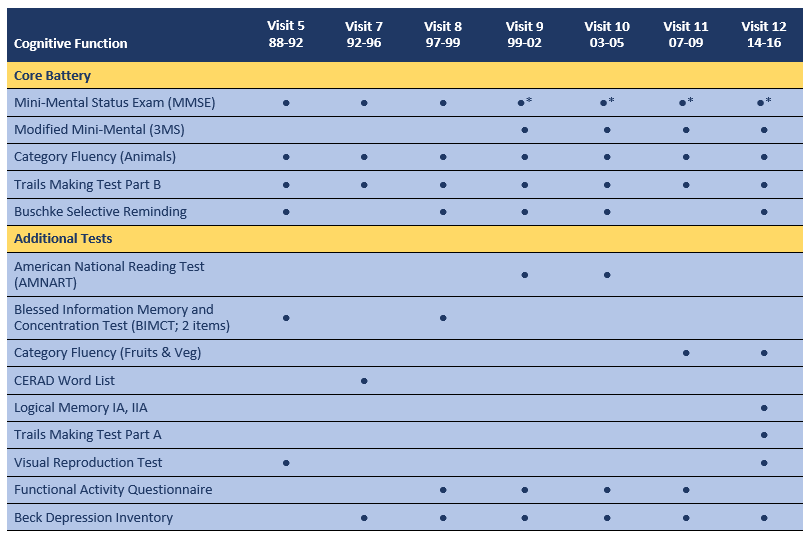Download Cognitive Function Data Dictionary
Cognitive function tests (CFTs) were introduced at Visit 5 (1988) and included at each subsequent visit. The test battery assesses multiple cognitive domains vulnerable to effects of aging and critical for maintenance of independence, such as episodic memory and executive function. The tests were selected in consultation with the Alzheimer’s Disease Research Center at the University of California, San Diego. All tests were administered by trained, certified personnel, with consistent administration and scoring across visits.
* Starting at Visit 9, the 3MS replaced the MMSE; MMSE scores are derived from the 3MS for Visits 8 through 12.
Test Description
Core Battery Administered at (Almost) Every Visit
Mini Mental State Exam (MMSE) 1 assesses orientation, registration, attention, calculation, language, and recall. Total score is provided, along with subscores for the Serial 7’s and WORLD backward subcomponents. At Visit 9 the MMSE was replaced by the Modified MMSE (3MS) 2, an expanded version of the MMSE which assesses a wider range of cognitive abilities. The 3MS was designed to permit derivation of the MMSE score, enabling direct comparison of results on the MMSE across all visits. For Visits 8 through 12 total 3MS score is provided, along with the calculated MMSE score, and the subcomponent scores of Serial 7’s and WORLD backward.
Trail-Making Test Part B (Trails B) from the Halstead-Reitan Neuropsychological Test Battery3 is a sensitive measure of executive function, in which participants are required to draw a line to connect, in ascending order, an alternating series of letters and numbers on a page. Scores reflect time to complete the test, with a maximum of 300 seconds allowed. The Trail Making Test Part A was only administered at Visit 12. Participants drew a line to connect a series of numbers in ascending order. Scores reflect time to complete the test, with a maximum of 150 seconds allowed.
Category Fluency (animals) 4 test is a verbal fluency test that assesses semantic memory and executive function. Participants are asked to name as many animals as possible within one minute. At Visits 11 and 12, participants were also asked to name as many fruits and vegetables as possible within 60 seconds.
Buschke Selective Reminding Test 5 assesses verbal episodic memory. Ten unrelated words are read to participants at a rate of one every two seconds. Immediately thereafter, the participant is asked to recall the entire list, and reminded of any words that were missed. The participant is asked to recall the entire list again. This procedure is followed for six trials. By examining the consistency of word recall across trials, words are determined to be in long term storage (starting on the first trial on which words were consecutively recalled twice) or in short term storage. Scores are provided for total number of words recalled from long term storage, and from short term storage, as well as overall total number of words recalled across all trials. After the 6th trial is completed, participants are tested on word recognition. Each of the ten words is paired with a word that was not presented, and the participant is asked which of the two words was included in the list of words to remember. The word recognition score reflects total number of correct responses. At Visit 12, a 20 minute delayed recall trial was also administered, in which participants were asked to list all words remembered. Number of words remembered forms the delayed recall score.
Additional Tests Administered at One or More Visits
American version of the Nelson Adult Reading Test (AMNART) 6 provides an estimate of verbal intelligence. Participants read aloud a list of 50 irregular words. Scores provided include the number of errors (incorrectly pronounced words) and estimated premorbid Wechsler Adult Intelligence Scale (WAIS) verbal IQ, calculated as VIQ = 129 – (0.919 x AMNART_ERR). 7
Blessed Information-Memory- Concentration Test (BIMC) 8. Two items that assess executive function and episodic memory were administered. Participants were asked to name the months of the year backward. They were allowed two attempts to answer correctly. They received a score of 2 if successful on the first attempt, 1 if successful on the second attempt, otherwise 0. They were also asked to recall a five-part name and address following a 10-minute delay, and received one point for each item correctly recalled without prompting.
Consortium to Establish a Registry for Alzheimer’s Disease (CERAD) Word List Memory Scale 9, assesses verbal episodic memory. Participants are shown 10 words, one at a time, at a rate of once every 2 seconds. Participants read each word aloud as they are presented. Then the participant is asked to recall as many words as possible. After a 90 second delay, the procedure is repeated. This procedure occurs for 3 trials. After a 5 minute delay, participants are asked to recall the words. A recognition test is then administered, in which 20 words are administered (10 new words and the 10 words from the memory list) and participants indicate whether each word was presented previously. Scores include the number of correctly recalled words on each of the 3 learning trials, the recall trial, and the recognition trial (total correctly identified as old or new). Total number of words recalled across all 3 learning trials, and percent savings are also provided.
Visual Reproduction Test. Russell’s 10 adaptation of the original Wechsler Memory Scale 11 was used to assess visual memory for geometric forms. Participants are shown three cards containing increasingly complex geometric figures. Each card is shown for 10 seconds, and the participant is asked to reproduce the figure(s) on the card immediately and after a 30-minute delay. Participants are then asked to copy each figure to enable control for visuospatial impairments. Total correct scores are provided for immediate recall, delayed recall, and copy trials.
Logical Memory IA and IIA from The Wechsler Logical Memory-Revised 12 is a test of verbal episodic memory in which participants are read a short paragraph (story A) and asked to recall as much of the story as possible immediately and after a 20-min delay. Scores reflect number of story concepts correctly recalled.
Pfeffer Functional Activities Questionnaire (FAQ) 13 is a survey of functional ability in which the participant or an informant is asked to rate ability to perform ten instrumental activities of daily living, such as ability to balance a check book or to shop independently. Modified response options included ability to perform the activity without difficulty (score of 0), requires assistance (score of 1), someone else has taken over the activity (score of 2), or “not applicable”. Total score across all applicable activities was divided by highest possible score (i.e. number of applicable activities multiplied by 2) to yield the FAQ score.
Beck Depression Inventory (BDI)14. The 21-item Beck Depression Inventory assesses symptoms of depression. Higher scores indicate higher level of depressed mood.
References
- Folstein MF, Folstein SE, McHugh PR. “Mini-mental state”. A practical method for grading the cognitive state of patients for the clinician. J Psychiatr Res. 1975;12(3):189-198.
- Teng EL, Chui HC. The Modified Mini-Mental State (3MS) examination. J Clin Psychiatry. 1987;48(8):314-318.
- Reitan R. Validity of the Trail Making Test as an indicator of organic brain damage. Percept Mot Skills. 1958;8:271-276.
- Butters N, Granholm E, Salmon DP, Grant I, Wolfe J. Episodic and semantic memory: a comparison of amnesic and demented patients. J Clin Exp Neuropsychol. 1987;9(5):479-497.
- Buschke H, Fuld PA. Evaluating storage, retention, and retrieval in disordered memory and learning. Neurology. 1974;24(11):1019-1025.
- Grober E, Sliwinski M. Development and validation of a model for estimating premorbid verbal intelligence in the elderly. J Clin Exp Neuropsychol. 1991;13(6):933-949.
- Nelson HE, Willison J. National Adult Reading Test (NART) test manual. Academia: http://www.academia.edu/2515150/National_Adult_Reading_Test_NART_test_manual_Part_1.
- Katzman R, Brown T, Fuld P, Peck A, Schechter R, Schimmel H. Validation of a short Orientation-Memory-Concentration Test of cognitive impairment. Am J Psychiatry. 1983;140(6):734-739.
- Morris JC, Heyman A, Mohs RC, et al. The Consortium to Establish a Registry for Alzheimer’s Disease (CERAD). Part I. Clinical and neuropsychological assessment of Alzheimer’s disease. Neurology. 1989;39(9):1159-1165.
- Russell EW. A multiple scoring method for the assessment of complex memory functions. J Consult Clin Psychol. 1975;43(6):800-809.
- Wechsler D. A standardized memory scale for clinical use. J Psychol. 1945;19:87-95.
- Wechsler D. Manual for the Wechsler Memory Scale-Revised. New York, NY: Psychological Corporation; 1987.
- Pfeffer RI, Kurosaki TT, Harrah CH, Jr., Chance JM, Filos S. Measurement of functional activities in older adults in the community. J Gerontol. 1982;37(3):323-329.
- Beck, A.T., Ward, C. H., Mendelson, M., Mock, J., & Erbaugh, J. (1961) An inventory for measuring depression. Archives of General Psychiatry, 4, 561-571.

